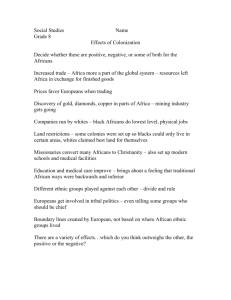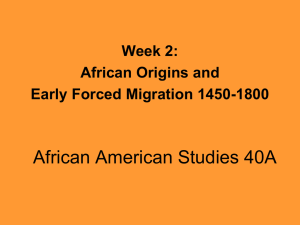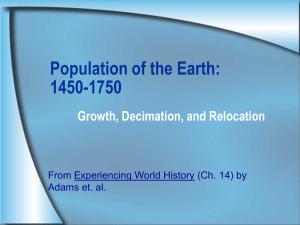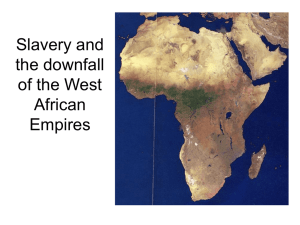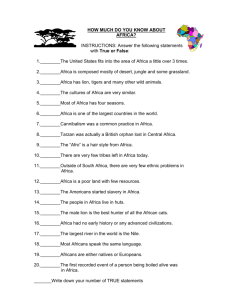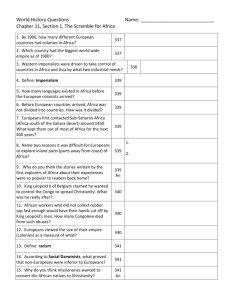Africa is the world's second largest continent
advertisement
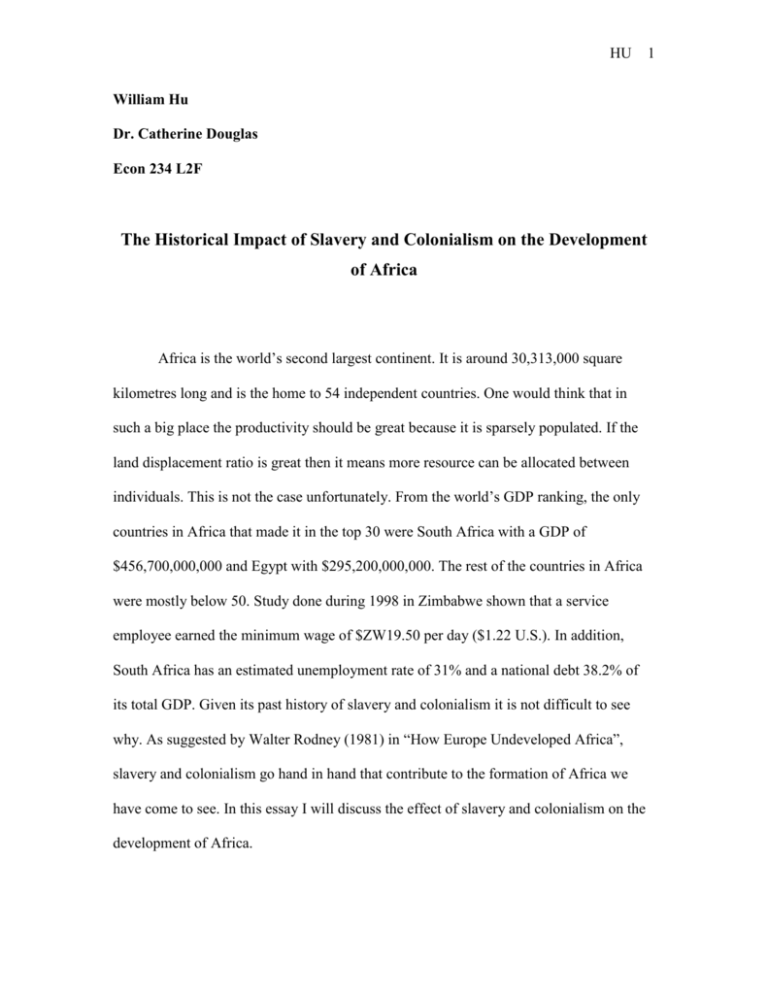
HU William Hu Dr. Catherine Douglas Econ 234 L2F The Historical Impact of Slavery and Colonialism on the Development of Africa Africa is the world’s second largest continent. It is around 30,313,000 square kilometres long and is the home to 54 independent countries. One would think that in such a big place the productivity should be great because it is sparsely populated. If the land displacement ratio is great then it means more resource can be allocated between individuals. This is not the case unfortunately. From the world’s GDP ranking, the only countries in Africa that made it in the top 30 were South Africa with a GDP of $456,700,000,000 and Egypt with $295,200,000,000. The rest of the countries in Africa were mostly below 50. Study done during 1998 in Zimbabwe shown that a service employee earned the minimum wage of $ZW19.50 per day ($1.22 U.S.). In addition, South Africa has an estimated unemployment rate of 31% and a national debt 38.2% of its total GDP. Given its past history of slavery and colonialism it is not difficult to see why. As suggested by Walter Rodney (1981) in “How Europe Undeveloped Africa”, slavery and colonialism go hand in hand that contribute to the formation of Africa we have come to see. In this essay I will discuss the effect of slavery and colonialism on the development of Africa. 1 HU 2 The slave trade changed Africa from a self-sufficient, developing continent to a disaster area by reducing the number of able labourers, by disrupting trades, and by destroying local industries. Slavery started around 1445 (Gage 6). When the new continent was “discovered”, colonists needed healthy and strong labourers so they provoked the Africans, who were trading with them at the time, to trade captives from enemy tribes to them. This was known as the triangle trade. As described by Findley (1990 p.1-5) the slaves were first shipped from West Africa to North America, and then they were forced to cultivate lands suitable for growing commodities such as cotton, sugar and rum. The raw materials were harvested and shipped to Europe where they would undergo additional processing. The Europeans used manufactured goods to pay for the slaves and to continue the trade cycle. It was estimated that around 12 million slaves arrived to work on European-run plantations. As Rodney (1981) described, “…The massive loss to the African labour force was made more critical because it was composed of able- bodied young men and young women. Slave buyers preferred their victims between the ages of fifteen and thirty-five, and preferably in the early twenties; the sex ratio being about two men to one woman. Europeans often accepted younger African children, but rarely any older person”. Of all the people captured only one in four made it to the New World alive. Many died either during the long trip on boat or from the long march to the interior from the coast. On the whole, Africa had lost in total 48 million of workers. Instead of contributing to their society, the slaves were forced to develop and enrich the Europeans. Eric Williams argued in his theory of “double stimulus” that the exported goods and imported goods together supplied the growth of the Industrial Revolution. In the same way, Inikori (1986 p.3) pointed out that depopulation from the HU 3 slave trade hindered the development of division of labour, transformation of technology, and destroyed commodity production for exports. For any economy to grow trading between one another is essential. Trade supports growth and employment. It also sparks up competition and leads to new breakthrough in technology. Because the Europeans actively encouraging slave trading, the roads used for trading became filled with tribes out to collect slaves. As a result, trade decreased. Furthermore, fields were abandoned for fear of being captured while working. This became problematic especially in a place with great population. As observed by Walt Rodney(1981): “…even the busiest African in West, Central, or East Africa was concerned more with trade than with production… In Africa, the trading groups could make no contribution to technological improvement because their role and preoccupation (with the slave trade) took their minds and energies away from production”. Because Europeans were trading commodities at a cheaper rate than the local businesses, many industries in Africa went out of business. This led to the decrease in the variety of native goods sold and increased economic dependence on outside forces, namely the Europeans. Colonialism brought many problems under the European’s ruling. Aside from the slave trading, another reason contributing to Africa’s underdevelopment was Colonialism. Colonialism is the political takeover of one nation by another. European colonists felt that it was faster to take control of the land rather than trading with the natives thus around 1833 the Colonists took over Africa and divided it among themselves. Little resistances were met because the Europeans had large armies that “persuaded” many village chiefs to give up their lands. The Berlin African Conference was held during 1884-1885. In that HU 4 period of time the European countries gathered and drew guidelines on which countries could have which bits of Africa. By 1914, all of Africa had been assigned with the exception of Liberia and Ethiopia (Gage 12). The arbitrary borders which were created with little or no attention to the native’s history and cultural backgrounds caused political instability. A common problem facing present Africa countries is the anti-government movement by guerrilla groups in attempt to free their comrades from the other side of borders. Government policies reforms are not easily passed because cultural/religious differences lead to various point of views. To meet the growing demand for commodities, the Europeans altered the crops African farmers traditionally grown and replace it with cash crops such as rubber plants, cottons, and sugar canes. This drastic change transformed the domestic agriculture to specialize in certain products that had little or no benefit to the natives. The amount of available and nutritional food that was originally intended for the population was reduced. Furthermore, for the Africans to specialize in something the Europeans need meant that there were no growth in African’s own technological because all the decisions were made by the colonists. The corroded soil from overuse of lands later contributed to Africa’s famine. In addition to the change made in farm crops, the colonists also exploited natural resources. As Rodney's book notes, railroads were being built in Europe, the Americas, and Africa. But in Africa, the means of transit and communication were not put in place to facilitate internal trade, but rather to seize Africa's wealth: "All roads and railways led down to the sea." First the Colonists bought the cheap raw minerals and crops from the Africans then sold them back to Europe for higher price. With the money earned from the sale, the colonist proceeded to buy manufactured goods from Europe and sold the goods at a higher price HU 5 to the Africans. In Zambia, it was said that out of 36.7 million dollars made 24.2 million dollars was send to the hand of stockholders back to England and only 2 million dollars was used to pay the labourers. An example of such act would be the gold rush fever in Chunya during 1933-1953. After the gold was extracted Chunya became one of the poorest countries in Africa because the Africans could not negotiate a decent price for the gold. The resource grab left Africa with a weak economic infrastructure. In Darity’s paper, it was suggested that factories were sited back in the European countries instead of Africa. The development of factories could have benefited Africa greatly. If the money made from Zambia’s mining had been reinvested to create refineries, employment opportunities might have been created and stimulate economic growth. To prevent the Africans from opening their own factories various measures were used. An example of such would be the 1931 law that made it illegal for banks to lend money to Africans. The problem with African countries was that even after obtaining independence they were still managing the same way as they did during colonial times. Countries used most of their lands to grow one or two specialized commodities instead of growing food that can sustain the local population. The way Europeans operated had affected the Africans into thinking that by buying expensive machineries their productivity would increase. What they did not recognize was that some of the new methods were doing more harm than good. An example of this would be introduction of tractor to plough fields. the dry soil changed into dustbowl under the heavy ploughs which in term increase the rate of soil erosion. The price of the commodities exported was less than that of the HU 6 technology imported. As a result, the Africans were in constant debts and generally worse off than during the colonial rule. Slavery and Colonialism created a weak economic infrastructure that is unsuitable for growth. Slavery decreased the labour force that is essential for the growth of economy. It also decreased the internal trading within Africa and caused native industries to close. In a similar way, colonialism contributed by depleting Africa’s natural resource. It also stripped employment opportunities for African workers and prevented the African’s from achieving a technological state that would enable them to be independent of the Europeans trade cycles (triangle trade and the slave-gun trade). The suffering of the Africans has become increasingly aware by the extensive media coverage. On top of being poor and undeveloped, Africa is also plagued by diseases such as AIDS and Malaria. Government is increasing the living standard by providing better health cares and educations. From the World Bank’s data it showed a decrease in the infant mortality rate from 42 to 31 per thousand live births (Brown, Flavin, et al.). Attempts of financial aids such as the International Monetary Fund have been offered but ultimately it is up to the countries’ government to unit and discusses how the funding should be utilized. HU 7 Work Citied: Brown R. Lester, Flavin Christopher, French Hilary, N. Abramovitz Janet, Dunn Seth, Gardner Gary, Mastny Lisa, Mattoon Ashley, Roodman David, Sampat Payal, O.Sheehan Molly, and Starke Linda. State of the World 2001. New York: W.W. Norton & Company, 2001 Gage, Susan. Colonialism in Africa: A Critical Look. Victoria: Victoria International Development Education Association, 1946 Darity, William. A model of “Original Sin”: Rise of the west and lag of the rest, The American Economic Review vol.82 (1992): 164-166 Findley, Ronald. The “triangle trade” and the Atlantic Economy of the eighteenth century: a simple general equilibrium model, Essays in International Finance no.177 (1990) 1-5, 22-24 Five Centuries of Going Backwards. 2 Dec 2004 <http://www.africa2000.com/BNDX/bao133.htm> CIA – the world fact book. 3 Dec 2004 <http://www.cia.gov/cia/publications/factbook/rankorder/2001rank.html> New Jersey AAH Curriculum Guide Resource Page – Walter Rodney. Mercer Deborah and Beckett Edith. New Jersey State Library. 2 Dec 2004 <http://www.njstatelib.org/NJ_Information/Digital_Collections/AAHCG/rodney.html> Asian Meltdown Hits Zimbabwe. Peck E. John. 1 Dec 2004 <http://www.zmag.org/ZMag/articles/pecksept98.html> The World Bank Group. 4 Dec 2004 <http://devdata.worldbank.org/external/CPProfile.asp?SelectedCountry=MNA&CCODE =MNA&CNAME=Middle+East+and+North+Africa&PTYPE=CP>

